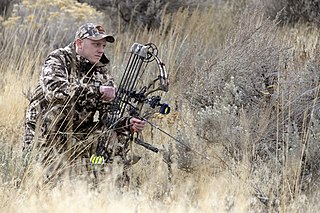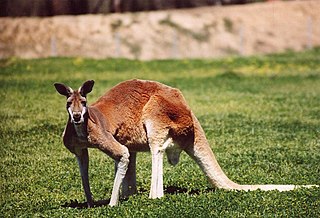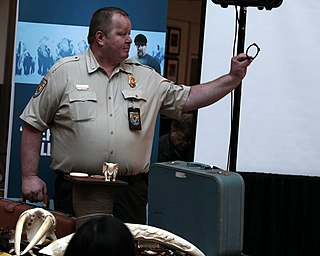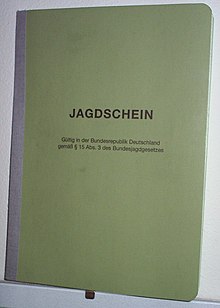
Hunting is the human practice of seeking, pursuing, capturing, or killing wildlife or feral animals. The most common reasons for humans to hunt are to exploit the animal's body for meat and useful animal products, for recreation/taxidermy, although it may also be done for non-exploitative reasons such as removing predators dangerous to humans or domestic animals, to eliminate pests and nuisance animals that damage crops/livestock/poultry or spread diseases, for trade/tourism, or for ecological conservation against overpopulation and invasive species.

Game or quarry is any wild animal hunted for animal products, for recreation ("sporting"), or for trophies. The species of animals hunted as game varies in different parts of the world and by different local jurisdictions, though most are terrestrial mammals and birds. Fish caught non-commercially are also referred to as game fish.
The Migratory Bird Treaty Act of 1918 (MBTA), codified at 16 U.S.C. §§ 703–712, is a United States federal law, first enacted in 1918 to implement the convention for the protection of migratory birds between the United States and Canada. The statute makes it unlawful without a waiver to pursue, hunt, take, capture, kill, or sell nearly 1,100 species of birds listed therein as migratory birds. The statute does not discriminate between live or dead birds and also grants full protection to any bird parts including feathers, eggs, and nests. A March 2020 update of the list increased the number of species to 1,093.

Trophy hunting is a form of hunting for sport in which parts of the hunted wild animals are kept and displayed as trophies. The animal being targeted, known as the "game", is typically a mature male specimen from a popular species of collectable interests, usually of large sizes, holding impressive horns, antlers, furs or manes. Most trophies consist of only select parts of the animal, which are prepared for display by a taxidermist. The parts most commonly kept vary by species, but often include head, hide, tusks, horns, or antlers.

The Kentucky Department of Fish and Wildlife Resources, an agency of the Kentucky Tourism, Arts and Heritage Cabinet, is responsible for the conservation of wildlife resources and for boating projects in the state. A commissioner appointed by the Fish and Wildlife Commission heads the department. The commission—which oversees the department's commissioner and promulgates regulations governing fishing, hunting, and boating—is a nine-member bipartisan board appointed by the governor from a list of candidates nominated by active hunters and anglers in each of nine geographic districts in the state.

Bowhunting is the practice of hunting game animals by archery. Many indigenous peoples have employed the technique as their primary hunting method for thousands of years, and it has survived into contemporary use for sport and hunting.

Wildlife management is the management process influencing interactions among and between wildlife, its habitats and people to achieve predefined impacts. It attempts to balance the needs of wildlife with the needs of people using the best available science. Wildlife management can include wildlife conservation, gamekeeping and pest control. Wildlife management draws on disciplines such as mathematics, chemistry, biology, ecology, climatology and geography to gain the best results.
Legislation on hunting with dogs is in place in many countries around the world. Legislation may regulate, or in some cases prohibit the use of dogs to hunt or flush wild animal species.

Waterfowl hunting is the practice of hunting aquatic birds such as ducks, geese and other waterfowls or shorebirds for food and sport.

Turtling is the hunting of turtles. Turtling has been a part of human culture since as far back as the middle of the first millennium BC, where sea turtles such as the hawksbill sea turtle were eaten as delicacies in countries such as China. While consumption and hunting of turtles is less common than it was in the past, this practice is still a part of communities throughout the globe, whether done legally or illegally.

The Michigan Department of Natural Resources (DNR) is the agency of the state of Michigan fo9unded in 1921, charged with maintaining natural resources such as state parks, state forests, and recreation areas. It is governed by a director appointed by the Governor and accepted by the Natural Resources Commission. Since 2023, the Director is Scott Bowen. The DNR has about 1,400 permanent employees, and over 1,600 seasonal employees.

Deer hunting is hunting deer for meat and sport, an activity which dates back tens of thousands of years. Venison, the name for deer meat, is a nutritious and natural food source of animal protein that can be obtained through deer hunting. There are many different types of deer around the world that are hunted for their meat. For sport, often hunters try to kill deer with the largest and most antlers to score them using inches. There are two different categories of antlers. They are typical and nontypical. They measure tine length, beam length, and beam mass by each tine. They will add all these measurements up to get a score. This score is the score without deductions. Deductions occur when the opposite tine is not the same length as it is opposite. That score is the deducted score.
The crossbow often has a complicated legal status due to its potential use for lethal purposes, and its similarities with both firearms and other archery weapons. The crossbow is, for legal purposes, often categorized as a firearm by various legal jurisdictions, despite the fact that no combustion is required to propel the projectile.
A hunting season is the designated time in which certain game animals can be killed in certain designated areas. In the United States, each state determines and sets its own specific dates to hunt the certain game animal, such as California, in which they designate certain zones, in which each have their own separate dates in order to legally hunt.

The kangaroo industry in Australia is based on the regulated harvesting of species of kangaroos.

A wildlife inspector is a person empowered by law to protect wildlife.
The Federal Aid in Wildlife Restoration Act of 1937, most often referred to as the Pittman–Robertson Act for its sponsors, Nevada Senator Key Pittman and Virginia Congressman Absalom Willis Robertson, is an act that imposes an 11% tax on firearms, ammunition, and archery equipment and distributes the proceeds to state governments for wildlife projects.

The United States Fish and Wildlife Service Office of Law Enforcement contributes to Service efforts to manage ecosystems, save endangered species, conserve migratory birds, preserve wildlife habitat, restore fisheries, combat invasive species, and promote international wildlife conservation. It is an office of the United States Fish and Wildlife Service (FWS).
Australia has a population of about 25 million, with the Commonwealth Government's 2019 survey estimating there are 640,000 recreational hunters in the country. There are around 5.8 million legally owned guns in Australia, ranging from airguns to single-shot, bolt-action, pump-action, lever-action or semi-automatic firearms.

Hunting is a significant subsistence and recreational activity in the United States. Regulation of hunting began in the 19th century. Some modern hunters see themselves as conservationists. American hunting tradition values fair chase, which values the balance between the hunter and the animals. A 2006 poll showed that 78% of Americans support hunting. 6% of Americans have hunted. Hunting is most popular in the Midwest.


















